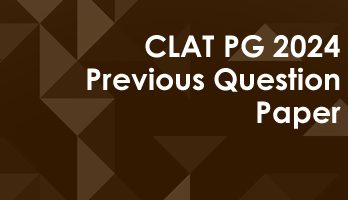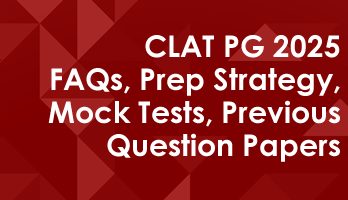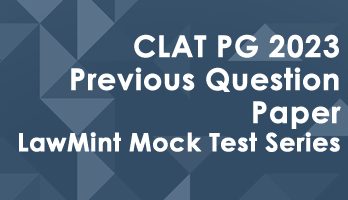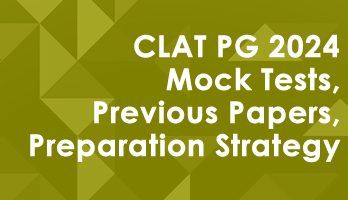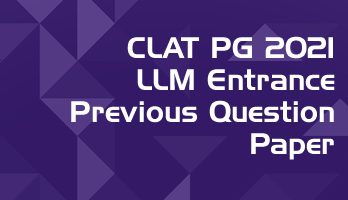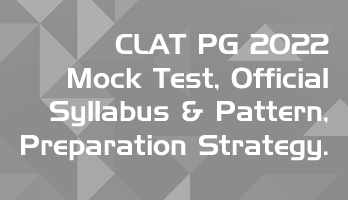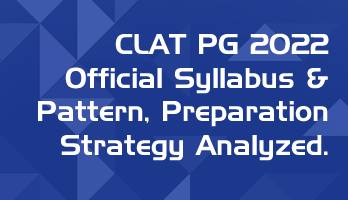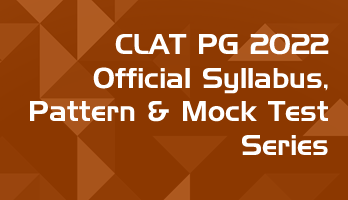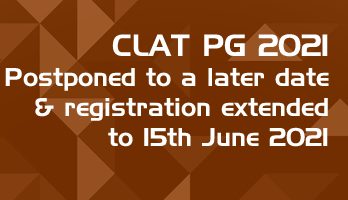This series of articles contains the complete CLAT PG 2020 question paper, conducted for the LLM admissions through the CLAT 2020 exam. In 2020, the pattern of the question paper was changed from the traditional MCQs to a ‘Comprehension based’ model. Each article in this series has one passage and the ten questions following it.
This article contains Passage 5 and the associated questions. The video embedded below discusses the answers as per the official key and the approach that can be used for such questions.
The answers to all the questions, for all the passages in the CLAT PG question paper are discussed in our YouTube video series at : https://www.youtube.com/lawmint
To make use of this question paper :
(1) The links to the complete series of articles is given below
(2) Read the passages and questions that follow
(3) Open our YouTube channel in another window or on your mobile phone (The video covering this specific passage is also embedded below.)
(4) Go through the series of videos where the answers to all the questions are discussed
The original plan by the CLAT Consortium was to have 10 passages, with 10 questions per passage and a subjective part. However, the subjective part was dropped and the number of passages was increased.
The CLAT PG 2020 exam had 12 passages, 120 questions – to be answered in 120 minutes. Click on the links below for the individual passages and the questions associated with the passage.
- Updated as per latest CLAT PG pattern
- Overall there are 300+ comprehension passages - with 2350+ questions
- 100 passages are provided as stand-alone mini mock tests
- 120 passages are combined to form 10 full-length mock tests
- 2020, 2021, 2022, 2023 and 2024 (New Pattern) Question papers included as mock tests
- Answers include the reason or 'rationale' for better understanding
- Order of the questions and answer choices are shuffled in every attempt for better practice
- The passages are of various lengths and complexities for better practice
- Unlimited access & practice - valid for one year from date of purchase
- Accessible 24 x 7 via Smart-Phone browsers and Desktops
- More the 100 LawMint users were selected by various top NLUs in 2020, 2021, 2022 and 2023 - Including NLSIU, NALSAR, NLU-J, WBNUJS
- Our users were also selected for the IIT KGP LLM, NLU Delhi (AILET PG) & DU LLM programs
Also included in the pack : (Useful for non-CLAT LLM entrance exams) :
- 11 CLAT PG old pattern previous Papers - 2009 to 2019 (as mock tests)
- 50 full-length old MCQ format mock tests (100 questions each)
- 50 old pattern MCQ mini-mock tests (25 questions each)
- Summarized overview of Important Jurisprudence topics (For Subjective & Objective questions)
- Overview of all Constitutional Amendments
- All Tests & Previous Papers are timed and have Negative marking for realistic simulation
- Questions & Answer Choices randomly shuffled in every attempt for better practice
Authentic Feedback from previous LawMint users :
I got AIR 21 in CLAT PG. Thank you so much. Your mocks helped me a lot in my preparation 🙂 - Ayushi Jain
I have subscribed to your CLAT PG program and got AIR 36 in this year CLAT PG. I have also secured AIR 54 in AILET PG exam. I would like to thank you. Your mock paper really helps a lot - Shrashank Tripathi
I would like to thank you for the CLAT PG LLM COURSE. Practising mock tests there helped me in getting confidence and hence I was able to get AIR 45 in CLAT PG LLM - Akshay Awasthi
A year back, I relied on the IIT Kharagpur RGSOIPL mock test series by LawMint to prepare for my RGSOIPL entrance test. Few months back, I relied on your UGC NET Law series to prepare for UGC NET. I was the topper of the RGSOIPL entrance, and have cracked JRF in UGC NET. All thanks to LawMint - Anshuman Sahoo
"I got AIR 18 in CLAT PG and General Category rank 28 in AILET PG. I want to thank you for helping me practice well in controlled conditions from any place. It gave me a lot of confidence and I took the tests while travelling too. I also made it to IIT Kharagpur." - Vinodharani
"Lawmint has been of great help to me in securing AIR 25 in AILET PG and AIR 29 in CLAT PG examinations. The subjective and objective approach of the test series kept me up to date with the latest exam pattern." - Bhawna Nanda
"I, Nimmy Saira Zachariah joined you clat test series. I cleared AILET PG with 30th rank. Your test series were of immense help as it gave me clear idea of where my preparations stand thank you once again law mint." - Nimmy S Z
"Hey guys. Where do I start? If I thought that getting AIR 59 in Clat PG was it, then how wrong I was. With Lawmint now I have cracked UGC NET as well." - Joyanta Chakraborty
- CLAT PG 2020 – Comprehension Passage 1
- CLAT PG 2020 – Comprehension Passage 2
- CLAT PG 2020 – Comprehension Passage 3
- CLAT PG 2020 – Comprehension Passage 4
- CLAT PG 2020 – Comprehension Passage 5
- CLAT PG 2020 – Comprehension Passage 6
- CLAT PG 2020 – Comprehension Passage 7
- CLAT PG 2020 – Comprehension Passage 8
- CLAT PG 2020 – Comprehension Passage 9
- CLAT PG 2020 – Comprehension Passage 10
- CLAT PG 2020 – Comprehension Passage 11
- CLAT PG 2020 – Comprehension Passage 12
CLAT PG Comprehension Passage 5
“The main argument on behalf of the Respondents was that the Government was bound by its promise and could not have resiled from it. They had an indefeasible legitimate expectation of continued employment, stemming from the Government Order dated 20.02.2002 which could not have been withdrawn. It was further submitted on behalf of the Respondents that they were not given an opportunity before the benefit that was promised, was taken away. To appreciate this contention of the Respondents, it is necessary to understand the concept of legitimate expectation.
14. The principle of legitimate expectation has been recognized by this Court in “Union of India v. Hindustan Development Corporation & Ors.” If the promise made by an authority is clear, unequivocal and unambiguous, a person can claim that the authority in all fairness should not act contrary to the promise.
15. M. Jagannadha Rao, J. elaborately elucidated on legitimate expectation in “Punjab Communications Ltd. v. Union of India & Ors.” He referred to the judgment in 2 (1993) 3 SCC 499 “Council of Civil Service Unions and Ors. v. Minister for the Civil Service” in which Lord Diplock had observed that for a legitimate expectation to arise, the decisions of the administrative authority must affect the person by depriving him of some benefit or advantage which, (i) he had in the past been permitted by the decision- maker to enjoy and which he can legitimately expect to be permitted to continue to do until there has been communicated to him some rational grounds for withdrawing it on which he has been given an opportunity to comment; or (ii) he has received assurance from the decision-maker that they will not be withdrawn without giving him first an opportunity of advancing reasons for contending that they should not be withdrawn.
Rao, J. observed in this case, that the procedural part of legitimate expectation relates to a representation that a hearing or other appropriate procedure will be afforded before the decision is made. The substantive part of the principle is that if a representation is made that a benefit of a substantive nature will be granted or if the person is already in receipt of the benefit, that it will be continued and not be substantially varied, then the same could be enforced.
16. It has been held by R. V. Raveendran, J. in “Ram Pravesh Singh v. State of Bihar” that legitimate expectation is not a legal right. Not being a right, it is not enforceable as such. It may entitle an expectant:
(a) to an opportunity to show cause before the expectation is dashed; or
(b) to an explanation as to the cause of denial. In appropriate cases, the Courts may grant a direction requiring the authority to follow the promised procedure or established practice. ”
Source: Excerpt taken from the judgment delivered by the bench of L. Nageshwar Rao & Hemant Gupta, J.J. in Kerala State Beverages (MandM) v. P P Suresh & Ors.,(2019) 9 SCC 710.
41. Which of the following statements cannot be identified as a limitation upon the Doctrine of Legitimate Expectation?
a) The concept of Legitimate Expectation is only procedural and has no substantive impact.
b) The doctrine does not apply to legislative activities.
c) The doctrine does not apply if it is contrary to Public Policy or against the Security of State.
d) There are parallels between the Doctrine of Legitimate Expectation and Promissory Estoppel.
42. Which of the following is not true in relation to the Doctrine of Legitimate Expectation as observed by the Supreme Court in ‘Monnet Ispat & Energy Ltd. v. Union of India’?
a) The Doctrine of Legitimate Expectation cannot be invoked as a substantive and enforceable right.
b) The Legitimate Expectation is different from anticipation and an anticipation cannot amount to an assertable expectation.
c) The Doctrine fails where an overriding public interest justifies the change in Administrative Policy.
d) The Doctrine of Legitimate Expectation is founded on the principles of reasonableness and fairness.
43. Which of the following cases can be traced as the origin of the Doctrine of Legitimate Expectation?
a) Attorney General of Hong Kong v. Ng Yeun Shiu, (1983) 2 AC 629.
b) Schmidt v. Secy. Of State for Home Affairs, (1969) 2 Ch 149 (CA).
c) Food Corporation of India v. Kamdhenu Cattle Feed Industries, AIR 1993 SC 1601.
d) Breen v. Amalgamated Engg. Union, (1971) 2 WLR 742.
44. Which of the following is not a ground for judicial review of a discretionary action of an Administrative Authority in India?
a) Failure to exercise discretion
b) Excess or abuse of discretion
c) A breach of rules of Natural Justice
d) None of the above
45. Which of the following statement is true in relation to “Empty formality” theory of the Principle of Natural Justice?
a) The plea for not following the Principle of Natural Justice is not sustainable on the grounds of Empty Formality.
b) The plea for not following the Principle of Natural Justice is sustainable on the grounds of Empty Formality.
c) The Empty Formality affords a legitimate ground for the avoidance of Principle of Natural Justice.
d) Both options (b) & (c) are correct.
46. What is the meaning of a writ of “Certiorarified mandamus’’?
a) A writ of Mandamus, issued against an adjudicating body to quash a decision.
b) A writ of Certiorari issued to an administrative body to quash its decision.
c) A simultaneous writ to quash a decision and also to give a direction.
d) A simultaneous writ to quash a direction and give a decision.
47. Which of the following is not a ground for holding a Delegated Legislation as invalid?
a) Parent Act delegates non-essential legislative functions.
b) Delegated legislation is inconsistent with the general law.
c) Parent Act itself is unconstitutional.
d) Delegated legislation is inconsistent with the Parent Act.
48. In which of the following cases, Hegde J observed that, “ Whenever a complaint is made before a court that some Principle of Natural Justice had been contravened, the court had to decide whether the observance of that rule was necessary for a just decision on the facts of that case.” ?
a) A.K. Kraipak v. Union of India
b) Maneka Gandhi v. Union of India
c) Union of India v. P.K. Roy
d) Dharampal Satyapal Ltd. v. CCE
49. Which of the following is not an essential condition before pressing the Doctrine of Estoppel into service or benefit contract?
a) A representation or conduct amounting to representation have been made.
b) He must have acted to his detriment or suffered as a result of such representation.
c) The other party to whom representation was made must have acted upon such representation.
d) The representation must have been made with the intention of not fulfilling it.
50. Suppose, students filled up JEE Mains form for 2020. Due to repeated postponements of JEE, IIT Kharagpur decided to opt out of JEE mains and conducted its own separate Test. On which of the following grounds the decision of IIT Kharagpur can be challenged?
a) Procedural fairness
b) Legitimate expectation
c) Manifest arbitrariness
d) IIT Kharagpur’s decision cannot be challenged as it was taken in the interest of the students.
- Updated as per latest CLAT PG pattern
- Overall there are 300+ comprehension passages - with 2350+ questions
- 100 passages are provided as stand-alone mini mock tests
- 120 passages are combined to form 10 full-length mock tests
- 2020, 2021, 2022, 2023 and 2024 (New Pattern) Question papers included as mock tests
- Answers include the reason or 'rationale' for better understanding
- Order of the questions and answer choices are shuffled in every attempt for better practice
- The passages are of various lengths and complexities for better practice
- Unlimited access & practice - valid for one year from date of purchase
- Accessible 24 x 7 via Smart-Phone browsers and Desktops
- More the 100 LawMint users were selected by various top NLUs in 2020, 2021, 2022 and 2023 - Including NLSIU, NALSAR, NLU-J, WBNUJS
- Our users were also selected for the IIT KGP LLM, NLU Delhi (AILET PG) & DU LLM programs
Also included in the pack : (Useful for non-CLAT LLM entrance exams) :
- 11 CLAT PG old pattern previous Papers - 2009 to 2019 (as mock tests)
- 50 full-length old MCQ format mock tests (100 questions each)
- 50 old pattern MCQ mini-mock tests (25 questions each)
- Summarized overview of Important Jurisprudence topics (For Subjective & Objective questions)
- Overview of all Constitutional Amendments
- All Tests & Previous Papers are timed and have Negative marking for realistic simulation
- Questions & Answer Choices randomly shuffled in every attempt for better practice
Authentic Feedback from previous LawMint users :
I got AIR 21 in CLAT PG. Thank you so much. Your mocks helped me a lot in my preparation 🙂 - Ayushi Jain
I have subscribed to your CLAT PG program and got AIR 36 in this year CLAT PG. I have also secured AIR 54 in AILET PG exam. I would like to thank you. Your mock paper really helps a lot - Shrashank Tripathi
I would like to thank you for the CLAT PG LLM COURSE. Practising mock tests there helped me in getting confidence and hence I was able to get AIR 45 in CLAT PG LLM - Akshay Awasthi
A year back, I relied on the IIT Kharagpur RGSOIPL mock test series by LawMint to prepare for my RGSOIPL entrance test. Few months back, I relied on your UGC NET Law series to prepare for UGC NET. I was the topper of the RGSOIPL entrance, and have cracked JRF in UGC NET. All thanks to LawMint - Anshuman Sahoo
"I got AIR 18 in CLAT PG and General Category rank 28 in AILET PG. I want to thank you for helping me practice well in controlled conditions from any place. It gave me a lot of confidence and I took the tests while travelling too. I also made it to IIT Kharagpur." - Vinodharani
"Lawmint has been of great help to me in securing AIR 25 in AILET PG and AIR 29 in CLAT PG examinations. The subjective and objective approach of the test series kept me up to date with the latest exam pattern." - Bhawna Nanda
"I, Nimmy Saira Zachariah joined you clat test series. I cleared AILET PG with 30th rank. Your test series were of immense help as it gave me clear idea of where my preparations stand thank you once again law mint." - Nimmy S Z
"Hey guys. Where do I start? If I thought that getting AIR 59 in Clat PG was it, then how wrong I was. With Lawmint now I have cracked UGC NET as well." - Joyanta Chakraborty


